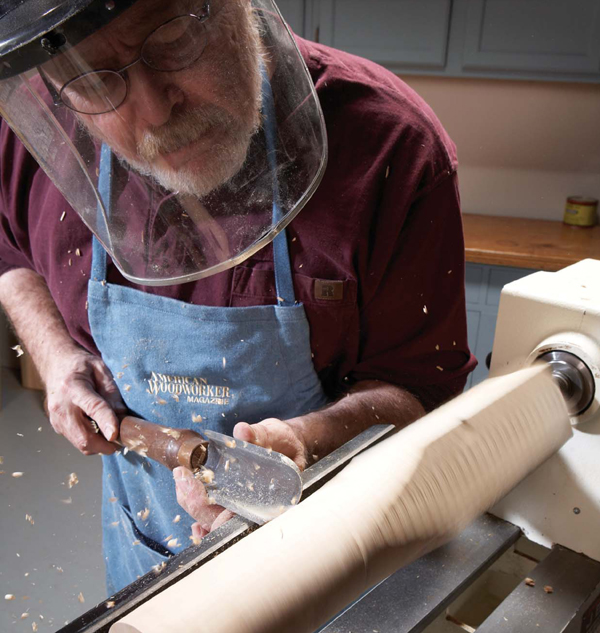
Master this basic turning tool

When I introduce someone to woodturning, I choose the spindle roughing gouge. When I work with kids, it’s the first tool I place in their hands. Why? Because, used correctly, the spindle roughing gouge is the safest, most user-friendly turning tool of them all. And don’t be fooled by its name. The spindle roughing gouge can leave a very clean surface. Master this tool, and you’ll learn basic techniques that apply to using virtually all cutting type turning tools. However, the spindle roughing gouge must be shaped and sharpened correctly and used in the appropriate applications—or its friendliness can quickly disappear.
Designed for spindle work A spindle roughing gouge is designed to quickly shape square wooden blanks that are mounted on the lathe so the grain runs parallel to the bed.
Borrowed from, and primarily made in England, this tool is deeply fluted (curved), and its cutting edge is straight (Photo 1). In the U.S., most turning sets come with a completely different roughing tool, a large, shallow gouge with a domed or fingernail shape. This tool looks a bit like a spindle detail gouge on steroids. Users of “American” style roughing gouges are usually instructed not to attempt removing a blank’s square corners on the lathe; instead, they’re directed to saw off the corners before mounting the blank.
Spindle roughing gouges are available in several sizes. My advice is to buy the largest size, as it simplifies a leveling cutting action (Photo 2). The spindle roughing gouge is not the best choice for detail work or for making quick turns. And don’t even think of using it to rough out a bowl or vessel blank (Photo 3). Its large surface area makes it awkward to maneuver in a confined space, its long straight edges leave exposed sides and corners that will easily catch, and its tang is not strong enough to engage the cutting edge far beyond the tool rest. Using a spindle roughing gouge for bowl turning is dangerous; use a bowl gouge instead.
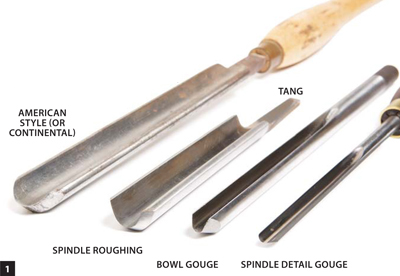
The spindle roughing gouge is one of four gouges commonly used for turning. It is instantly recognizable by its deeply fluted semi-circular shape, vertically ground edge and tang-style end.
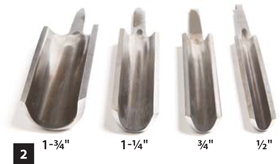
Spindle roughing gouges come in several different sizes. Widths are measured across the inside of the flute. You don’t need them all; just buy the largest size you can find.

Never use a spindle roughing gouge—a tang-type tool—for bowl turning. A bowl gouge is machined from solid rod, so it can extend far beyond the tool rest, to reach deep inside a bowl.
The spindle roughing gouge is a great choice for creating cylinders of any size (Photo 4). And it’s the best tool for removing the corners on any square stock measuring up to 5" x 5" (much faster than tilting the table saw blade and running the stock through numerous times; it’s safer, too). The spindle roughing gouge handles straight tapers with ease, and it can also produce tapers that are slightly convex or concave. Don’t ask this tool to turn quickly or detail—is simply does not perform these tasks with a lot of control.
The spindle roughing gouge is a cutting tool (some turning tools are designed for scraping), so the edge requires support from the bevel during use. Start with the flute on the tool rest and the handle held low (Photo 5). Point the flute in the direction of travel. Move the tool forward so its bevel contacts the wood (no wood chips or dust should fly when the bevel touches). Raise the handle slightly, to engage the wood—make sure the cutting occurs on the leading half of the flute. Then move the tool in the intended direction. When you change directions, the tool’s orientation reverses, so the opposite half of the flute does the cutting.
It’s safe to cut anywhere along the leading half of the flute. If the tool’s leading corner touches the wood, it won’t catch; only a lifting of wood fibers will occur.
If you raise the handle too far, the tool will stop cutting and begin to scrape. Scraping dulls the tool, tears the wood surface and takes more energy to make the cut—this usually results in some loss of control.
To rough a square blank (remove the corners, that is), start in the middle (Photo 6). When working difficult woods that are quite hard or “chippy,” it’s best to nibble off the corners in several light passes rather than with a few heavy cuts.
For concave and convex shapes, work from larger to smaller diameters (Photos 7 and 8). To make smooth finishing cuts, angle the tool about 45° to the axis of the lathe and make light cuts (Photo 9).
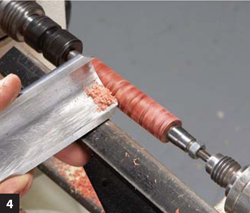
Use the spindle roughing gouge on any surface that is cylindrical or gently tapered. The stock’s size doesn’t matter: A large tool will always do a better job of leveling the surface than a small one.

To use the spindle roughing gouge, hold the handle low and point the flute in the direction of travel. Engage the wood and move in the intended direction.
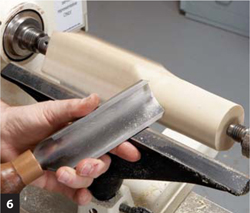
To remove the corners from a square blank, start in the middle and move toward the end. Reverse directions to finish the job.

The spindle roughing gouge can create long tapers and shallow concave or convex shapes. Always work curved shapes from large to small diameters—the concave portion of this leg must be worked from both directions.

Virtually all of the shapes on this handle can be completed with the spindle roughing gouge. Rolling the ends and cutting the flat area for the ferrule are the exceptions.
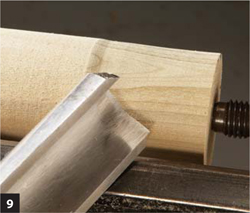
Although it’s called a “roughing” gouge, this tool can leave a very clean surface if you make light cuts. The surface on the left resulted from a heavy cut.
Preparing any turning tool for use includes these three steps: Shaping the profile, putting an edge on that shape by grinding, and completing the edge by honing. When viewed from above, the spindle roughing gouge’s edge should run straight across (Photo 10). From the side, the edge should appear vertical or canted back at the top, no more than 5° (Photo 11). If your gouge does not have this profile, regrind it so it does. To shape the profile, set your grinder’s tool rest so it is perpendicular to the face of the wheel. Once you’ve shaped the profile, set your grinder’s tool rest to create the 45° bevel angle that will sharpen the profile’s edge. Hold the tool flat on the rest, with the tool’s edge parallel with the grinding wheel. Start at one corner and slowly roll the tool to the other corner (Photo 12). Grind with control, slowly and deliberately. Be sure the grinding wheel’s first contacts are at the bevel’s back edge—never just below the cutting edge. Stop grinding when the sparks are gently coming over the top of the tool and appear evenly along the edge.
Here’s a bench test for sharpness: If the edge appears black under a light, the tool is sharp. If you see white along the edge, it isn’t. (The edge of a sharp tool is ground to a point. Flat—non sharp—areas appear white, because they reflect the light.)

The edge of this spindle roughing gouge is properly shaped. When viewed from above, the edge runs straight across.

When viewed from the side, the edge appears vertical. It can also cant slightly back. The edge should never extend forward at the top.
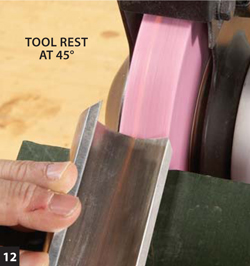
To sharpen the tool, grind a 45° bevel behind the edge. Hold the tool parallel with the wheel’s edge and flat on the tool rest. Then roll it slowly from corner to corner. Stop grinding when the sparks appear evenly along the edge.

Hone the edge. With the slipstone touching only the back of the bevel, start an up and down motion on the outside edge. Then, without coming off of the back, touch the area just below the cutting edge. Maintain this two-point contact to hone effectively.

Use the slipstone’s rounded edge to hone the inside. Hold the slipstone flat in the flute and move in an out, following the flute’s curve, without tipping forward over the edge.
To achieve (and maintain) a fine edge, you must hone the tool, using a slipstone (a hone with a rounded edge). For the best results with today’s woodturning tool steels, plan to use diamond plated honing materials. Hone the outside of the edge first (Photo 13). As you hone, be sure to maintain two points of contact on the bevel. The hone can bridge the bevel because the bevel is slightly concave, thanks to the radius of the grinding wheel. If you lift off the back of the bevel while honing, you will get a rolled (also called dubbed) edge—this will actually have a dulling effect.
To hone the inside edge, hold the slipstone flat in the tool’s flute and follow the curve (Photo 14). If you tip over the outside of the edge you will dull it.
While using the tool, hone it at the first signs of dullness (more pressure required to cut, torn fibers, short chips or dust, a flat or dull sound when cutting). Return to the grinder if honing requires removing too much steel (because the concave area of the bevel has disappeared, or because you let the tool get too dull for honing), or if the edge was somehow damaged.